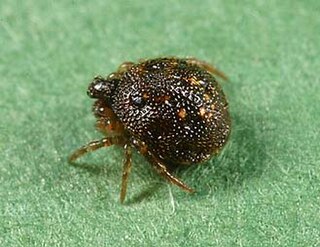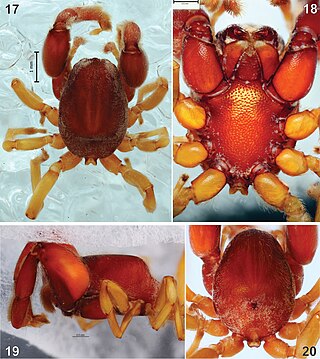
Nursery web spiders (Pisauridae) is a family of araneomorph spiders first described by Eugène Simon in 1890. They resemble wolf spiders (Lycosidae) except for several key differences. Wolf spiders have two very prominent eyes in addition to the other six, while a nursery web spider's eyes are all about the same size. Additionally, female nursery web spiders carry their egg sacs with their jaws and pedipalps instead of attaching them to their spinnerets as wolf spiders do. When the eggs are about to hatch, a female spider builds a nursery "tent", places her egg sac inside, and stands guard outside, hence the family's common name. Like the wolf spiders, however, the nursery web spiders are roaming hunters that don't use webs for catching prey.

Ground spiders comprise Gnaphosidae, the seventh largest spider family with over 2,000 described species in over 100 genera distributed worldwide. There are 105 species known to central Europe, and common genera include Gnaphosa, Drassodes, Micaria, Cesonia, Zelotes and many others. They are closely related to Clubionidae. At present, no ground spiders are known to be seriously venomous to humans.

Pirate spiders, members of the family Mimetidae, are araneomorph spiders which typically feed on other spiders.

Ant spiders are members of the family Zodariidae. They are small to medium-sized eight-eyed spiders found in all tropical and subtropical regions of South America, Africa, Madagascar, Australia-New Guinea, New Zealand, Arabia and the Indian subcontinent. Most species are daytime hunters and live together with ants, mimicking their behavior and sometimes even their chemical traits. Although little is known about most zodariids, members of the genus Zodarion apparently feed only on ants; a number of other genera in the family are apparently also ant specialists.

Liocranidae is a family of araneomorph spiders first described by Eugène Simon in 1897. They are one of several groups called "sac spiders". The holarctic genus Agroeca is the best-known, but it also includes various genera of more obscure spiders that still lack a diagnosis. Two species in the North American genus Neoanagraphis are found in the extremely dry conditions in the Mojave, Sonoran and Chihuahuan deserts. Females live in animal burrows while males wander and are the ones most often caught in pitfall traps.

Cithaeronidae is a small family of araneomorph spiders first described by Simon in 1893 Female Cithaeron are about 5 to 7 millimetres long, males about 4 millimetres (0.16 in).

Prodidominae is a family of spider, sometimes called long-spinneret ground spiders. It was formerly regarded as a subfamily of Gnaphosidae, but was raised to a family in 2022.
Penestomus is a genus of African araneomorph spiders in the family Penestomidae, and was first described by Eugène Louis Simon in 1902. The genus was formerly included in the family Eresidae, but was elevated to its own family in 2010. It is now considered closer to Zodariidae.
Hermippus is a genus of ant eating spiders in the family Zodariidae, containing twelve species restricted to Asia and parts of Africa. Three new species were discovered in 2014.

Phoroncidia is a genus of comb-footed spiders that was first described by J. O. Westwood in 1835.

Palpimanus is a genus of palp-footed spiders that was first described by L. Dufour in 1820.

Asceua is a genus of Asian ant spiders first described by Tamerlan Thorell in 1887.
Caesetius is a genus of spiders in the family Zodariidae. It was first described in 1893 by Simon. As of 2017, it contains 10 species from southern Africa.
Capheris is a genus of spiders in the family Zodariidae. It was first described in 1893 by Simon. As of 2017, it contains 11 species, all from sub-Saharan Africa.
Cicynethus is a genus of spiders in the family Zodariidae. It was first described in 1910 by Simon. As of 2022, it contains 7 species.
Cydrela is a genus of spiders in the family Zodariidae. It was first described in 1873 by Thorell. As of 2022, it contains 17 species from a variety of places in Asia and Africa.
Heradida is a genus of spiders in the family Zodariidae. It was first described in 1893 by Simon. As of 2021, it contains 8 African species.
Leprolochus is a genus of spiders in the family Zodariidae. It was first described in 1893 by Simon. As of 2017, it contains 7 South American species.

Mallinus is a genus of spiders in the family Zodariidae. It was first described in 1893 by Simon. As of 2021, it contains only 1 African species.
Systenoplacis is a genus of spiders in the family Zodariidae. It was first described in 1907 by Simon. As of 2017, it contains 22 African species.










